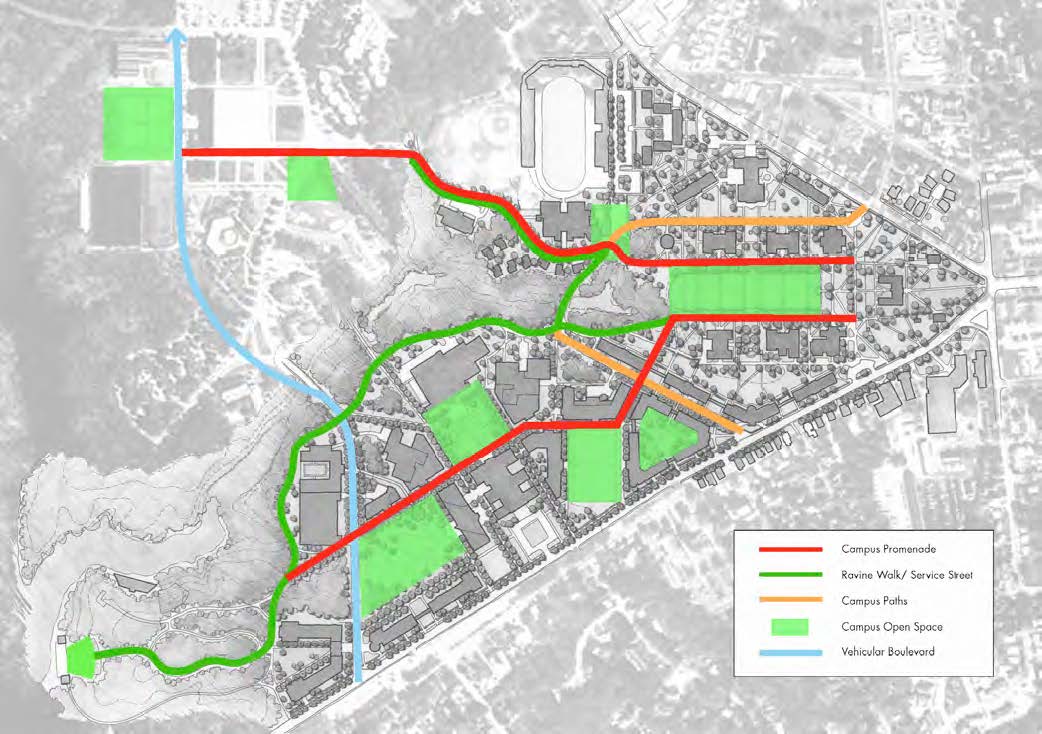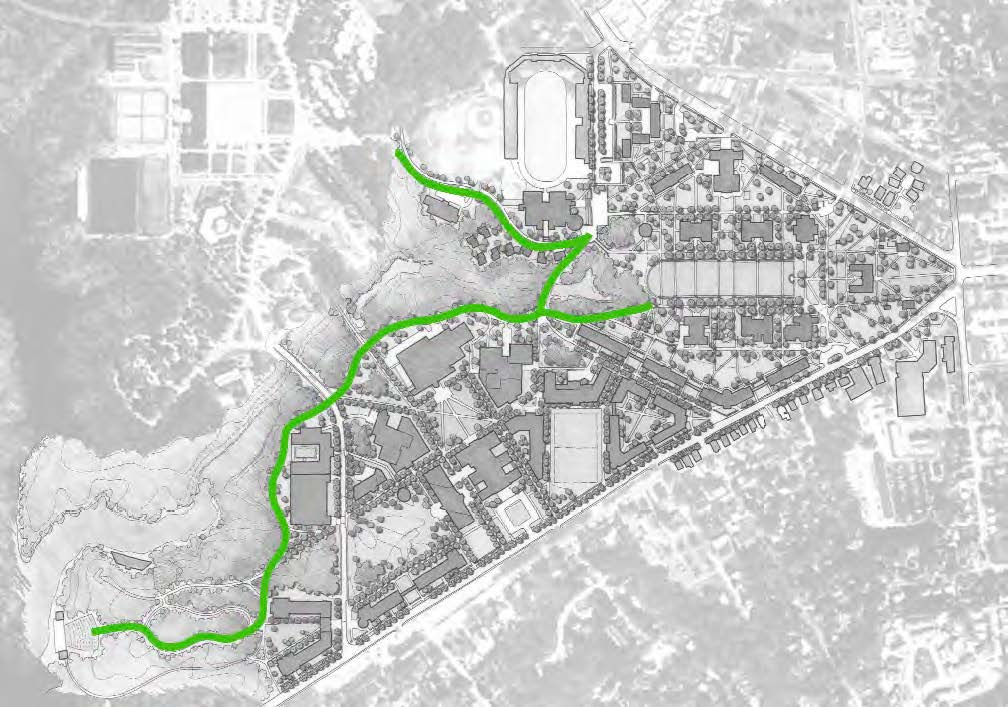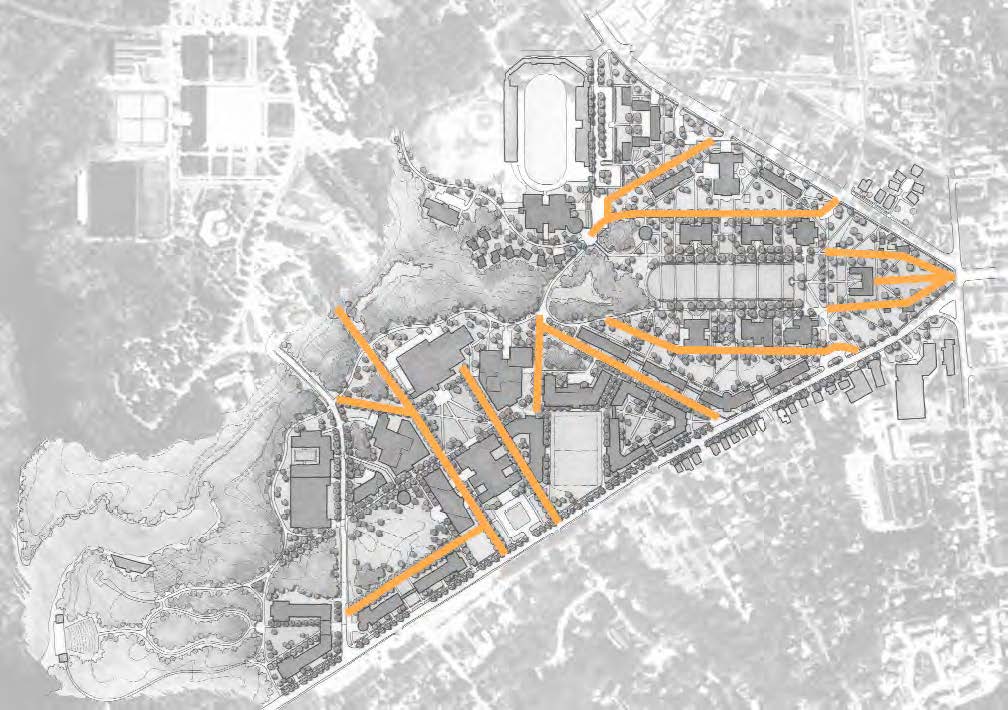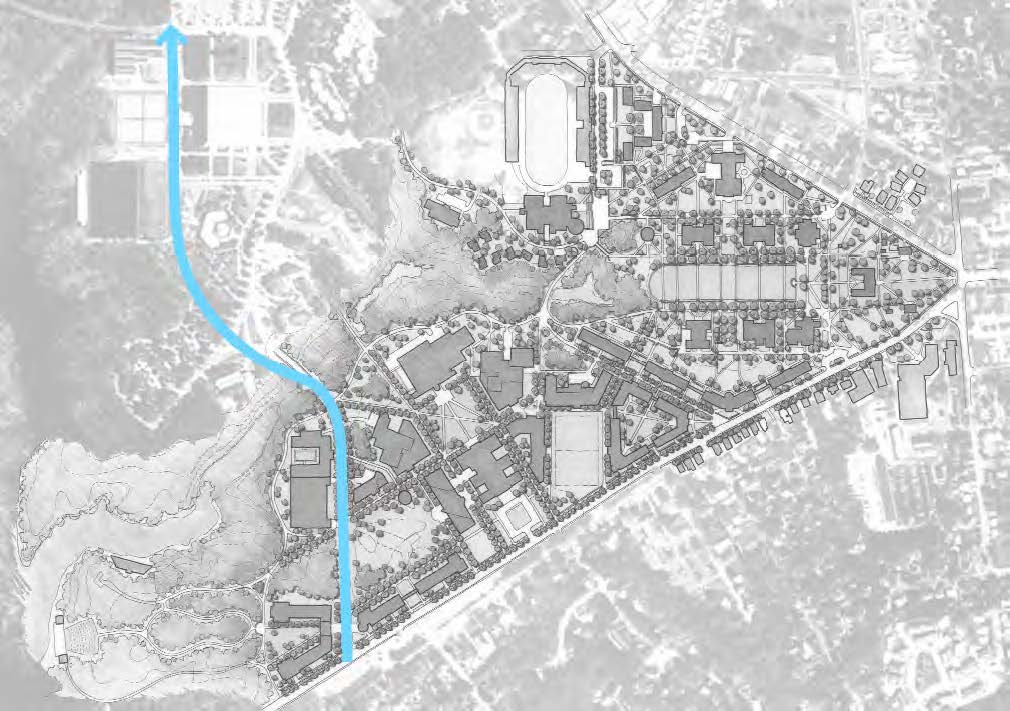Landscape Design Guidelines
The Vision Plan establishes a circulation structure, which connects existing memorable places (such as the Sunken Garden ) with newly created campus public spaces. It also eliminates physical barriers and provides improved pedestrian access to campus buildings and public spaces. The landscape order of pedestrian and vehicular circulation plays a key role in achieving this Vision Plan goal. In this landscape design guidelines section, a general set of approaches to pedestrian walk types, vehicular circulation strategies and structured parking opportunities is addressed.
The landscape element strategy also supports the Vision Plan. They include implementation of campus standards, including gateways, edges, bridges, campus lighting, and campus furnishings. Planting treatments are also addressed according to selected campus settings. Finally, the landscape guidelines include selected focus areas as examples that illustrate how both landscape order and elements can be realized as part of the overall Vision Plan.
Landscape Order
The guidelines for landscape order are comprised of the following categories:
- Campus Promenades
- Ravine Walk
- Campus Path
- Vehicular
Each category is described below.
Campus Promenades
 The campus promenades identified in the circulation framework plan are the prominent pedestrian walks that will connect to east and west campus destinations. The design of these promenades will use the perimeter walks at the Sunken Garden as a model. The promenades should consistently receive the following treatment:
The campus promenades identified in the circulation framework plan are the prominent pedestrian walks that will connect to east and west campus destinations. The design of these promenades will use the perimeter walks at the Sunken Garden as a model. The promenades should consistently receive the following treatment:
- Similar brick paving pattern as that of the Sunken Garden walks.
- Walk width should generally match that of the Sunken Garden , approximately 10 to 12 feet, but may vary depending on the campus setting.
- Generally straight walk alignments that connect to building entrances and campus public spaces should be implemented.
- Canopy tree species should be located on both sides of the walk at regular intervals and with a consistent setback from the walk edge.
- Pedestrian pole lights should be located between the trees at regular intervals.
- Site furnishings should include benches and trash receptacles.
- Stairways should be avoided unless necessary due to extreme terrain conditions.
Ravine Walks
 The Ravine Walks will celebrate the university's proximity to this landscape feature, following the Ravine edge and accommodating pedestrian and bike traffic. They will also provide limited service access to buildings along certain sections of the walks. They will be less formal in nature than the promenades and will have the following characteristics. The proposed Ravine Walk shown will also serve as an extension of the Campus Promenade.
The Ravine Walks will celebrate the university's proximity to this landscape feature, following the Ravine edge and accommodating pedestrian and bike traffic. They will also provide limited service access to buildings along certain sections of the walks. They will be less formal in nature than the promenades and will have the following characteristics. The proposed Ravine Walk shown will also serve as an extension of the Campus Promenade.
- An 8- to 10-foot-wide asphalt path for pedestrian and bike use.
- When pedestrian and service operations overlap, a 12-foot-wide asphalt vehicular travel way and a 4-foot-wide brick-band pedestrian way will be used.
- Gracefully curved alignments that follow the Ravine edge and accommodate existing tree stands.
- Native canopy and understory trees located informally along the walks.
- Pedestrian pole lights located at regular intervals.
Campus Paths
 All other campus pedestrian walks will be considered campus paths. As such, they will share the following characteristics:
All other campus pedestrian walks will be considered campus paths. As such, they will share the following characteristics:
- Brick paving with generally straight alignments.
- A 6- to 8-foot width at minor paths; 8- to 12-foot width at major paths.
- A 12-foot-wide brick vehicular travel lane and 4-foot-wide brick paving band for pedestrian paths utilized by both service vehicles and pedestrians.
- Pedestrian pole lights located at regular intervals.
- Unified planting of canopy trees.
Vehicular Circulation
 As mentioned previously, the Vision Plan proposes that most vehicular movement be restricted to the periphery of the core campus on a north-south Campus Boulevard . This boulevard starts at Jamestown Road , connects the existing Campus Drive to the north-south section of Brooks Street , and continues to Compton Drive .
As mentioned previously, the Vision Plan proposes that most vehicular movement be restricted to the periphery of the core campus on a north-south Campus Boulevard . This boulevard starts at Jamestown Road , connects the existing Campus Drive to the north-south section of Brooks Street , and continues to Compton Drive .
The Campus Boulevard presents an opportunity to enhance a portion of the existing campus drive by implementing well-defined crosswalks, gateways, campus plantings and roadway lighting. Once constructed, the boulevard should generally maintain the existing consistent travel ways and allow parallel parking to slow traffic and protect pedestrians. Road width and curbing should be adjusted to allow for clearly defined crosswalks at the Campus Promenade and Ravine Walk intersections. These crosswalks should be designed with traffic-calming techniques, such as raised walks which meet flush with perimeter curbs and a change of pavement.
Within the core campus, limited drop-off and short-term parking should be available at specific building entrances. Service access should be sited on designated pedestrian paths specifically designed for that purpose.
The plan builds upon recommendations in the 1987 Master Plan and other studies in proposing that surface parking lots in the core campus be replaced with structured parking decks at the campus periphery. The plan supports the planned construction of a new parking facility in the southwest section of the campus along Campus Drive. The location of the proposed parking structure connected to the Campus Center is affirmed. Finally, the existing parking lot north of William & Mary Hall and Compton Drive is identified as a location for a third facility.
Landscape Elements
A basic means of unifying the campus landscape is to use a consistent palette of elements. There are existing elements on the campus which, if adopted as a standard, would support the integration of the campus environment.
Edges and Gateways
Existing edges of the Old Campus are strongly identified by the university's brick walls and gateways. Providing campus boundaries, including vehicular and pedestrian arrival points, is important to the perception of a strong campus identity. Developing and enhancing these boundaries will help people understand the campus, navigate through it with a level of comfort, and recall it through its character. The vehicular and pedestrian gateways associated with the Old Campus should be preserved and used as a model along Jamestown Road . A high level of detail and craftsmanship associated with proposed structures is critical as part of its implementation. Perforated brick walls are an effective screening device at building service and utility areas.
The wooden painted picket fences should be maintained at the university's residential-scale properties and along Richmond Road. Picket fencing is proposed along the south side of Jamestown Road to better identify the university's white houses. Picket fences, in combination with a simple landscape treatment in front of the houses, would allow more direct views of houses and create a better campus identity on both sides of Jamestown Road .
Bridges
The university has an opportunity to celebrate the crossing of ravines by introducing highly expressive bridge structures. The pedestrian-scaled bridges (i.e., suspension-bridge type) could provide more direct connections to campus destinations while respecting the steep wooded slopes of the Ravine. The existing Campus Drive Bridge does not celebrate the presence of the Ravine below.
Campus Lighting
Campus lighting standards are an integral part of unifying a campus landscape. It is recommended that both the existing lighting fixtures in Wren Yard and the unique lighting at building entrances be maintained in their present states. Throughout the remainder of the campus, the William & Mary luminaire with cut-off capability should be used, either in a 12- to 14-foot height at pedestrian paths or at 18- to 20-foot heights at vehicular roadways.
Campus Furnishings
Standard campus furnishings will help to integrate the campus environment at a pedestrian scale. It is recommended that the following campus furnishings be adopted as campus standards:
- Benches: wooden bench on a brick paving pad.
- Bollards: stained wooden post with chains. Bollards placed at walk edges should be spaced at regular intervals.
- Trash Receptacles: black metal, ribbon-style with removable liner.
- Bicycle Racks: black “wave” rack on a brick paving pad.
Plantings
The William & Mary campus has a rich botanical heritage. Native and introduced plantings have resulted in a landscape of tremendous diversity and historical value that requires a strong commitment to preservation, rehabilitation and restructuring/redesign strategies. Planting recommendations are outlined by selected areas on the campus. Levels of guideline recommendations as they pertain to the campus plantings are as follows:
- Preserve
Implies the least amount of visual and physical change. The landscape is fitting in character and should be protected and maintained. Its condition must be ensured with informed maintenance.
- Restore
Requires action to recreate the appearance of an area as it existed at some point in the past. The landscape may have been subject to misinterpretations of the original design, have become overgrown, or have gradually declined.
- Rehabilitate
Rehabilitation preserves character, defining features but allowing changes that would improve the utility or function of a property. This is the most flexible preservation treatment, allowing modifications for contemporary use and restoration of important features where critical.
Wren Yard
The primary landscape objective in Wren Yard is preservation.
- Maintain lawn areas with high-branching canopy trees.
- Selectively prune plantings to improve sightlines to building facades.
- Long-term tree replacement should consider placement for optimal views to building entrances.
- Limit new tree plantings to species appropriate to the Colonial period.
Sunken Garden
The objective for the Sunken Garden is restoration.
- Initiate cultural landscape report of historic campus plantings.
- Selectively prune trees to improve sight lines to building façades and entrances.
- Remediate soil compaction at beech trees along perimeter walks.
- Lower boxwood hedge to open up views across the Sunken Garden .
Barrett and Blow Yards
The objective for the Blow Yard is rehabilitation.
- Initiate cultural landscape report of historic campus plantings.
- Reintroduce sight lines with appropriate plantings at Barrett Yard.
- Remediate soil compaction at Blow Yard.
- Open up sight lines and pedestrian connections from Blow Memorial Hall across to Barrett Hall, emphasizing this historic north-south connection.
Ravine
The objective at the Ravine is preservation and restoration.
- Reinforce visual connections from the Sunken Garden to Crim Dell and the Ravine through a unified landscape treatment and maintenance.
- Remove invasive plant species (for example, bamboo).
- Preserve and restore native plant canopy and understory trees appropriate to Ravine setting.
- Stabilize Ravine banks with native groundcover.
Living Remembrance Program
- Increase contribution amount to support maintenance costs.
- Develop list of appropriate trees and locations from which donors can choose to support landscape capital outlay programs and landscape guidelines.
Focus Areas
South Campus Focus Areas
On the South Campus, Library Quad, Landrum Walk, and Jamestown Road have been examined in greater detail.
The Swem Library Quad provides an opportunity to create a major public space on the South Campus. In support of this objective, the guidelines propose additions to Millington Hall, Small Physical Laboratory, and Muscarelle Museum of Art that build out to the boundaries of the quad, thereby improving its definition and legibility. The landscape treatment of this space can support this objective by clearly defining the South Campus Promenade and other pedestrian circulation paths in this area. The treatment of the quad itself would be simplified by removing the formal garden planted in the quad's center, and simplifying this space with a treatment of lawn and canopy shade trees.
Landrum Road currently divides the New Campus from the Old Campus. The guidelines propose that this drive be reconfigured as a pedestrian path that also provides limited service access to facilities along its route. By reducing the scale of this vehicular route, the two areas of the campus it flanks will be perceived more as a single entity.
The university's holdings along the north side of Jamestown Road present an opportunity to establish a positive campus identity by means of a consistent edge treatment for visitors approaching by that route. To that end, the guidelines recommend that new buildings along the north side of this street face the street and maintain an eave height and roof treatment consistent with Barrett and Jefferson Halls. Ideally, the site wall between these buildings and Jamestown Road should be continued along its entire length. The parcels owned by the university on the south side of the street, which have smaller-scaled buildings, should receive a consistent fence edge. Both sides, as possible, should be planted with street trees.
North Campus Focus Area
On the North Campus, University Center has been identified as an area of special potential and currently is occupied by roads and parking.
At the east end of University Center, an opportunity exists to create a memorable public space on the North Campus. The guidelines recommend that a plaza be created in this location. The plaza, which will be located along the North Campus Promenade, will define a public gathering place with University Center as its backdrop.
There is an opportunity to bridge directly from the new University Center across the Ravine to the Sunken Garden. This will directly connect the Sunken Garden to the University Center and also let people engage the Ravine.
In addition, the parcel southeast of this location, which abuts the Sunken Garden, has been identified as an appropriate location for public art or an iconographic building.














